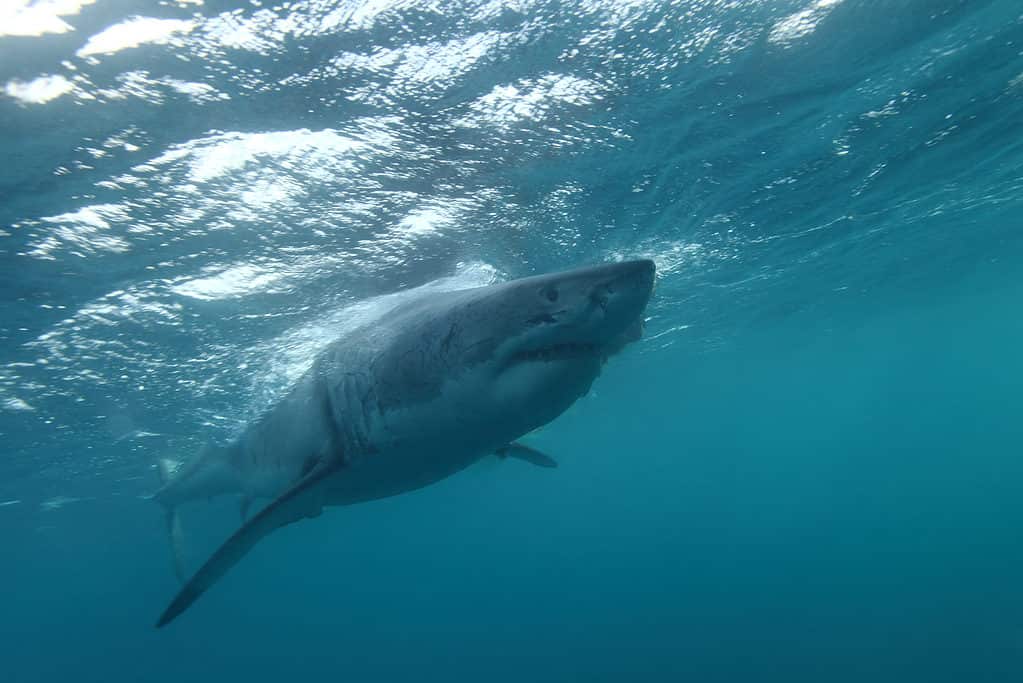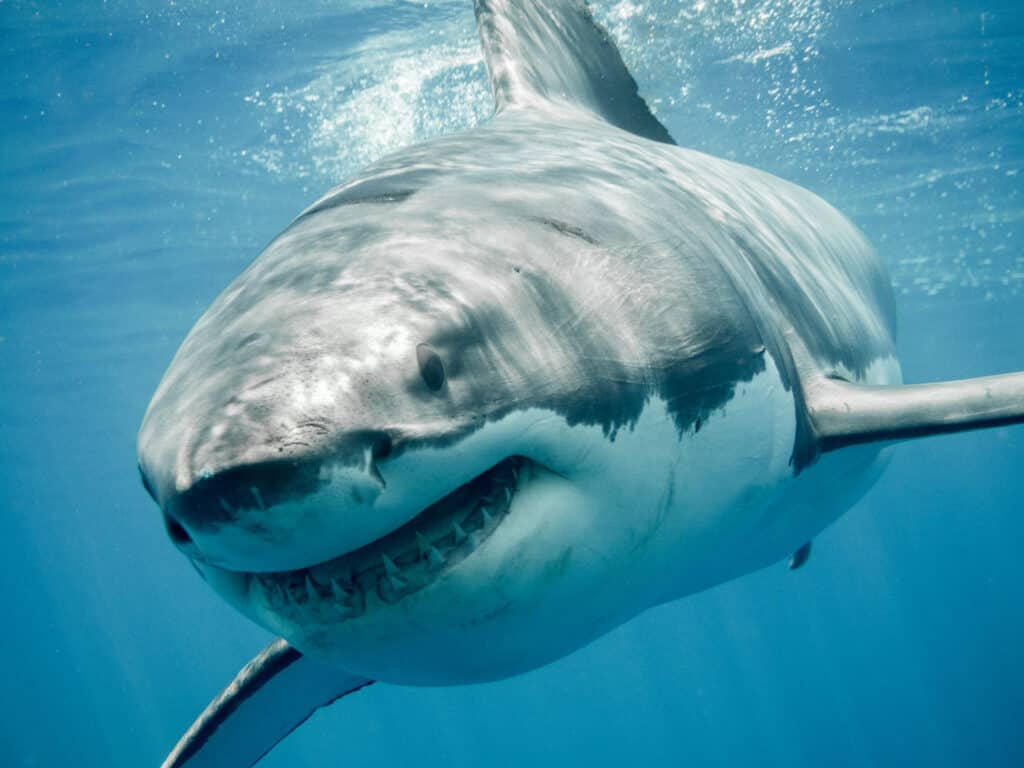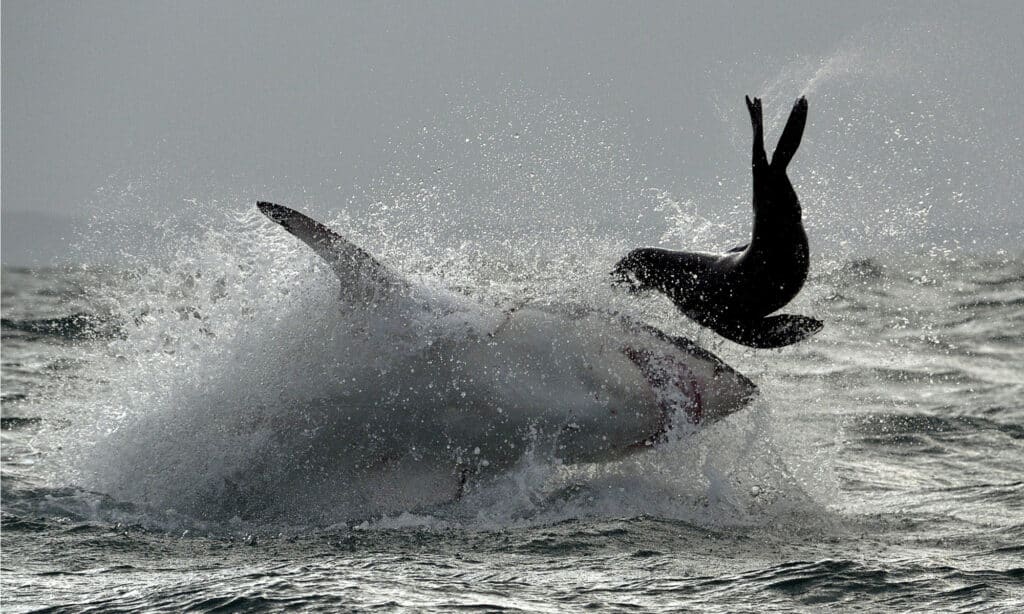Great white sharks (Carcharodon carcharia) spend most of their lives in the ocean depths, so we still know relatively little about them. One non-profit organization is out to change that. OCEARCH is a global non-profit whose mission is to educate the world about great white sharks while preserving and protecting these apex predators and balance-keepers of the world’s oceans. Thanks to OCEARCH’s tagging expeditions, we know some great white sharks were recent visitors off the coast of Daytona Beach, Florida.
Martha
Martha is a female great white shark that OCEARCH tagged on August 13, 2020, in Cape Cod, Massachusetts. They named her after Martha’s Vineyard on the nearby island.
At her tagging, Martha was a juvenile great white shark, already seven feet long but only weighing 188 pounds. At maturity, Martha could measure 16 feet or longer and weigh more than 2,400 pounds. Mature female great white sharks are significantly larger than males.
Since Martha was tagged in 2020, she has logged nearly 8,600 miles of travel. Her northernmost ping on record was off the coast of Cape Breton Island, Nova Scotia. Her southernmost ping is also the most recent. OCEARCH received a ping from Martha’s tracker on February 6, 2023, off the coast of Daytona Beach.

Female great white sharks grow quite a bit larger than males.
©iStock.com/Alessandro De Maddalena
Bob
Bob is another shark currently tracked by OCEARCH scientists. He was tagged on September 20, 2021, off the coast of Ironbound Island, Nova Scotia. At tagging, this adult male great white shark measured 13 feet 4 inches long and weighed 1,308 pounds. Bob was named after OCEARCH Chief Scientist Dr. Robert (Bob) Hueter, a pioneer in shark science for more than 40 years.
Bob (the shark, not the scientist) has logged well over 3,200 miles of travel since researchers tagged him. That tagging in Nova Scotia also marks Bob’s northernmost ping on record. His most recent ping is also his most southern recorded location when Bob showed up off the coast of Daytona Beach on November 7, 2022. However, Bob recently showed himself again with a Z-ping on January 17, 2023. Z-pings aren’t able to be geo-located, though.

Tagging great white sharks allows researchers to track these elusive, secretive animals.
©Alessandro De Maddalena/Shutterstock.com
Pings and Z-Pings
The devices that OCEARCH places on sharks allow researchers to track a shark’s location if the shark surfaces and remains at the water’s surface for a minimum of 90 seconds. This allows three consecutive pings, which are necessary to record an accurate location.
A Z-ping occurs when OCEARCH receives a single device ping, perhaps when a shark surfaced but only momentarily. There is not enough data in a Z-ping to provide researchers with accurate geo-positioning information, but Z-pings are still valuable. For example, Bob’s latest Z-ping may not tell us exactly where he is currently swimming, but we know he’s still out there somewhere off of the Atlantic coast of the United States.

OCEARCH’s tracking devices help monitor the health and population of the ocean’s apex predators.
©Ramon Carretero/Shutterstock.com
Shark Capital of the World
Volusia County, Florida (where Daytona Beach is located) is known as the shark capital of the world because more human/shark encounters have been recorded there than anywhere else on the planet. In 2022, there were seven documented shark bites in Volusia County alone. The state of Florida accounted for more than one-quarter of all the world’s shark bites in 2022.

The “World’s Most Famous Beach” isn’t just popular among people. Great white sharks love it, too.
©iStock.com/SeanPavonePhoto
Where Is Daytona Beach Located on a Map?
Daytona Beach is situated in east-central Florida on Volusia County’s eastern edge, close to the Atlantic coastline. It’s around 230 miles northwest of Miami, 90 miles southeast of Jacksonville, and about 42 miles northeast of Orlando. It is included in the Deltona–Daytona Beach–Ormond Beach metropolitan area.
Why Do Sharks Attack Humans?
When a shark bites a human, it’s almost always because the shark mistook the human for its natural prey. In the case of great white sharks, their natural diet includes sea turtles, seals, porpoises, dolphins, small whales, and fish.
As a human swimmer splashes about, a shark may mistake that swimmer for an injured fish. Surfers can be mistaken for seals. When a shark does bite a human, it normally releases as soon as it realizes that the human is not the prey animal it was seeking. Of course, this is not always the case. Sharks are the ocean’s apex predators. They are wild and unpredictable.

Attacks on humans are almost always because the great white shark mistakes the human for natural prey.
©Sergey Uryadnikov/Shutterstock.com
Beachgoers, Take Note
While the number of shark bites is still quite low compared to the number of people who step into Florida’s ocean waters each year, it certainly should put swimmers on alert. When heading out for a day at the beach in the Sunshine State, pay close attention to the most up-to-date local reports. While at the beach, constantly be aware of your surroundings.
After all, we know for certain that Martha and Bob like to frequent these waters, as do many of their great white friends.
The photo featured at the top of this post is © iStock.com/Whitepointer
Thank you for reading! Have some feedback for us? Contact the AZ Animals editorial team.






